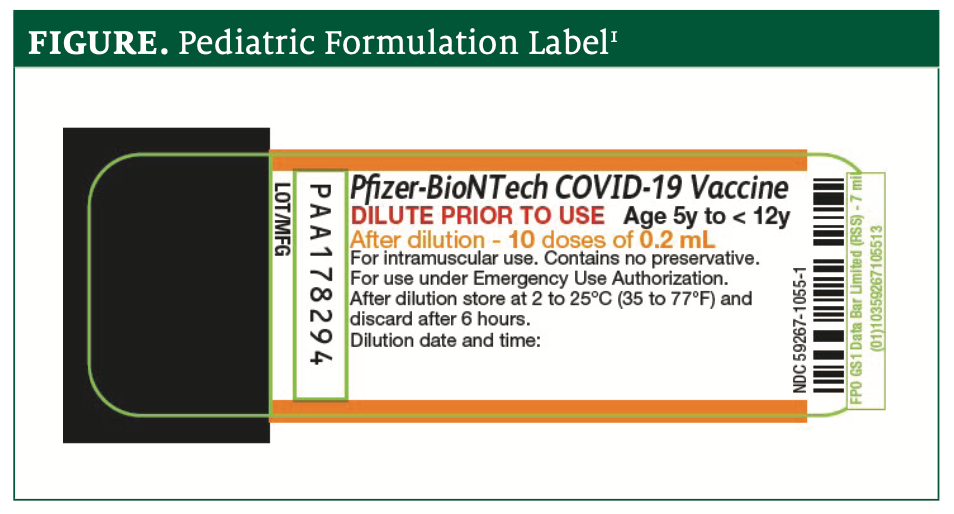
Publication
Article
Pharmacy Times
Be Aware of Age-Related Mix-Ups of COVID-19 Vaccines
Author(s):
Institute for safe medication practices receives hundreds of reports of incorrect doses for children.
Since the FDA authorized emergency use of the pediatric Pfizer-BioNTech COVID-19 vaccine for children aged 5 to 11 years on October 29, 2021, the Institute for Safe Medication Practices (ISMP) has received hundreds of reports involving mix-ups between the formulation for individuals 12 years or older and the pediatric formulation.
Most of the mix-ups have occurred in ambulatory or outpatient care settings, such as community pharmacies, outpatient clinics, physician offices, and public health clinics. The errors have resulted in wrong doses for children aged 5 to 11 years (over- and underdoses) and 12 years or older (underdoses). In response, a National Alert Network alert was issued on December 6, 2021, to raise awareness and recommend ways to prevent errors.1
Some of the errors submitted to the ISMP have involved syringe or vial mix-ups. The pediatric formulation (10 mcg/0.2 mL after dilution) of the Pfizer-BioNTech COVID-19 vaccine is supplied in a multiple-dose vial with an orange border on the label and an orange cap. The formulation for individuals 12 years and older has a purple cap. The pediatric formulation label states “Age 5y to <12y” (Figure1), but this is not as prominent as “Dilute Prior to Use” and could be missed. In addition, the dose in mcg is not listed on the label, which would be helpful in differentiating this product from the 30 mcg/0.3 mL formulations for patients 12 years and older.

Although different color caps on the Pfizer-BioNTech COVID-19 vaccines might help prevent some mix-ups, once the cap is removed and discarded, doses sometimes are prepared one at a time rather than all at once, which would render the cap color irrelevant. Also, it is unlikely that the vial would accompany prepared syringes, so the vial label cannot be verified by those administering the vaccine or parents or patients receiving the vaccine.
In other reported cases, the formulation intended for individuals 12 years and older was used for children aged 5 to 11 years, as it was thought to be acceptable if only 10 mcg was given, either as 0.1 mL of the 30 mcg/0.3 mL vaccine (10 mcg) or by diluting the 10-mcg dose in a syringe to 0.2 mL. However, neither method is correct, as either too little or too much vaccine would likely be injected. The pediatric vaccine is specifically formulated to be more diluted to ensure accurate measurement. The vaccine formulated for individuals 12 years and older should never be used to prepare doses for children aged 5 to 11 years.
Other factors contributing to these vaccine mix-ups include high patient volume, vaccinators being unaware of the proper dose for a child based on their age, vaccinators failing to correctly identify or verify the patient’s age, and vaccinators not knowing that a pediatric formulation exists.
Safe Practice Recommentations
Here are some tips to ensure that the right doses are administered.
1. Ask the parent or patient to provide 2 patient identifiers at the pharmacy counter or when checking in a patient to receive a vaccine: their full name and date of birth. Repeat this process immediately prior to vaccine administration. For pediatric patients, also verify the patient’s actual age with the parent or caregiver, and ask which vaccine(s) they have requested.
2. Bring only the intended, labeled vaccine syringe(s) for 1 patient into the vaccination area at a time. Involve the parent or patient in verifying the vaccine by reading the label to confirm the correct vaccine.
3. Clearly label all individual syringes containing vaccines. To facilitate this labeling, print labels for each patient or provide vaccine preparers with sets of preprinted labels that differentiate the doses for individuals 12 years and older and pediatric patients.
4. Document the vaccine expiration date, or date of manufacture, and lot number prior to vaccine administration. Then document administration afterward in the patient’s profile, on vaccination records, and via state or other immunization registries.
5. Ensure adequate staffing. Ideally, staff should not be expected to accomplish both regular dispensing functions and vaccine administration simultaneously.
6. Report all vaccine errors internally and to the FDA/CDC Vaccine Adverse Event Reporting System, which is mandatory for COVID-19 vaccine errors under an Emergency Use Authorization.2 The ISMP also asks providers to report vaccine errors to the ISMP National Vaccine Errors Reporting Program.3
7. Segregate and store the vaccines that are organized and properly labeled in freezers or refrigerators. Store the COVID-19 vaccines for individuals 12 years and older separately from the pediatric vaccines.
8. Use barcode scanning whenever possible to verify that the correct product has been retrieved during the production and/or verification phase of the dispensing process. Ideally, prior to administration, barcode scanning should again confirm the correct vaccine.
Michael J. Gaunt, PharmD, is a medication safety analyst and the editor of ISMP Medication Safety Alert! Community/Ambulatory Care newsletter at the Institute for Safe Medication Practices in Horsham, Pennsylvania.
References
1. Age-related COVID-19 vaccine mix-ups. Institute for Safe Medication Practices. December 6, 2021. Accessed January 14, 2022. https://www.ismp.org/alerts/age-related-covid-19-vaccine-mix-ups
2. Vaccine Adverse Event Reporting System. US Department of Health and Human Services. Accessed January 14, 2022. https:// vaers.hhs.gov/
3. Report an error. Institute for Safe Medication Practices. Accessed January 14, 2022. https://www.ismp.org/report-medication-error

2 Commerce Drive
Cranbury, NJ 08512
All rights reserved.





